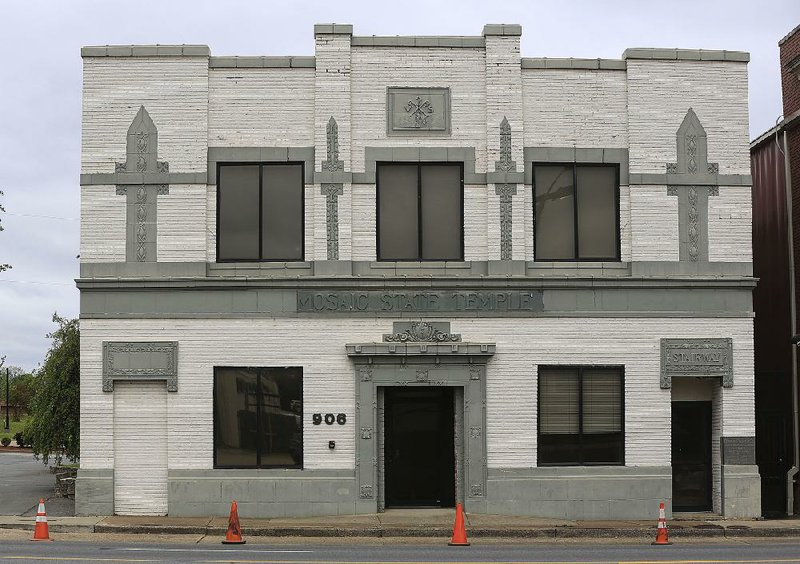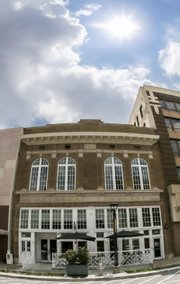The Mosaic Templars State Temple in Little Rock has been added to the National Register of Historic Places along with a one-room church in Logan County, a Cold War ammunition depot in East Camden and nine other Arkansas properties.
They were nominated in April by the state review board of the Arkansas Historic Preservation Program, which announced the new National Register listings Friday.
Mark Christ, a spokesman for the program, said the 12 properties illustrate the "rich variety of Arkansas' historic resources" and the importance of preserving our shared heritage as Arkansans.
The Mosaic Templars of America was founded in Little Rock in 1882 by two former slaves, John Edward Bush and Chester W. Keatts, according to the nomination form.
The organization was founded the year after a study by the Prudential Insurance Co. of America showed that black people had a higher mortality rate than whites, prompting many insurance companies to charge them higher rates or refuse to insure them altogether.
"The Mosaic Templars organization offered illness, death and burial insurance to African Americans at a time when white insurers did not treat black customers equally," according to the nomination. "The name derived from the name of Moses, and the Mosaic Templars' purpose was linked to Moses' leadership role in leading the Israelites out of slavery in Egypt. ... At its peak, the Mosaic Templars had over 100,000 members in chapters in 26 states, the Caribbean, and South and Central America."
Built in 1921, the organization's State Temple was in a two-story building at 906 South Broadway in downtown Little Rock. It served as the state headquarters for the Mosaic Templars, said Christina Shutt, director of the Mosaic Templars Cultural Center, which is in a nearby building that served as the organization's national headquarters.
The National Grand Temple burned in 2005 and an annex burned in 1984. Both were rebuilt in 2007 and opened in 2008 as the Mosaic Templars Cultural Center, a museum of the Department of Arkansas Heritage.
"The Mosaic Templars State Temple is the last remaining historic building associated with the Mosaic Templars of America headquarters, and its prominent location at 9th and Broadway, which was the heart of Little Rock's (and the state's) African-American business district, helps to illustrate the organization's importance in the state's black community," according to the nomination.
Shutt said the State Temple was designed by W.T Bailey, a black architect, and built at the height of the Jim Crow era.
"That's pretty significant," she said. "It's not as common as you'd think to find an African-American architect, especially during that time period."
The 1930s brought the demise of the Mosaic Templars of America, which, like many organizations, felt the effects of the Great Depression, according to the nomination. The building served a variety of purposes since then, including as an animal hospital and as a medical clinic.
The exterior walls of the State Temple were originally red brick with light-colored terra cotta decoration, according to the nomination. But the brick walls were painted white and the terra cotta was painted green sometime after 1992. Windows also were replaced after that year.
Shutt said the Arkansas Department of Heritage bought the Mosaic Templars State Temple in March 2017 for $950,000. Jameson Architects of Little Rock will do restoration work on the building this summer, she said. Afterward, the Heritage Department will lease office space in the building to other organizations.
The Mount Salem Church and School near Paris in Logan County also has been listed on the National Register. The white, one-room, wood-frame building was constructed in 1909-1910, according to the nomination. The structure is topped by a steep, metal-sheet clad gable roof. A cemetery is across the gravel road.
"The original community that surrounded the church would have consisted of small homesteads and possibly scattered commercial structures, which have now all been lost," according to the nomination. "The forest now surrounds the property and the nearby cemetery."
Like many churches in rural Arkansas, the building also served as a school. Now, it's used for community gatherings, including an annual "Homecoming," cemetery decoration days, weddings and funerals for the cemetery, according to the nomination.
Two properties associated with the Shumaker Naval Ammunition Depot at East Camden in Calhoun County also made the National Register list this time. They include the administration building, which was built around 1945, and the 500-man barracks, built around 1951 to house civilian workers at the base.
Other Arkansas properties that made the list are:
• The Carpenter Building at Gentry. It was built in 1927 by architect A.O. Clarke and housed a mortuary, funeral chapel, grocery store and furniture store.
• The C.A. Stuck & Sons Lumber office building at Jonesboro. Built in 1889, it was the headquarters of the region's largest lumber company.
• The Nevada County Courthouse in Prescott. It was built in 1964 from a design by Weaver and Hiegel Associates reflecting New Formalism, an architectural style that "gave the building an air of prestige befitting its governmental purpose while adding a touch of mid-century modern style," according to the nomination.
• Washington Street Historic District boundary increase at Camden, which added several historically significant residential blocks of Agee Avenue with buildings dating from 1847 to 1960.
• The Lockesburg High School gymnasium at Lockesburg in Sevier County. The concrete-block structure was built in 1952-53.
• Deepwood House near Fayetteville. Built around 1960 from an organic-style design by architect Herb Fowler, "Deepwood House's location on the edge of a bluff on Kessler Mountain allows it to nestle into the side of the mountain and not dominate its site," according to the National Register nomination.
• The Fulk-Arkansas Democrat Building at Little Rock. Built in 1916, the structure was designed in the neoclassical style by architect Charles L. Thompson to house the Arkansas Democrat newspaper's printing press, reporters and business offices, according to the National Register nomination. The building remained the headquarters for the Arkansas Democrat from its completion in 1917 until the early 1930s. The Arkansas Democrat is now known as the Arkansas Democrat-Gazette.
• The Carmichael House near Little Rock. Built around 1935, the craftsman-style structure has several associated outbuildings. It was part of the John Hugh and Lily M. (Beauchamp) Carmichael estate.
Metro on 06/02/2018

